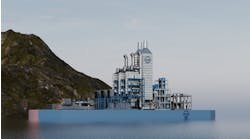Supercomputing cluster to assist subsalt imaging in Red Sea
Offshore staff
DHAHRAN, Saudi Arabia -- Saudi Aramco has added a new super-computing system to its EXPEC Computer Center (ECC) to support the company’s exploration effort in the Red Sea and frontier areas, and to help optimize field development/improved recovery programs. The installed storage is 1,050 terabytes (TB), the largest such addition in the company’s history.
“ECC provides the technical computing required by Exploration and Producing (E&P) to maintain a capacity of 12 MMb/d of oil and to meet the demands for non-associated gas,” said AbdulAziz AbdulKarim, ECC general manager.
The increased storage means that ECC can move over 60 gigabytes using the latest high-speed/high-density disk technologies, the company says. Also, the new 1,050 TB of storage fits in 12 racks, compared with 27 racks for the 650 TB of storage replaces, while requiring less power and cooling.
“This installation…helped us to surpass a remarkable milestone on data migration process automation, which was completed four times faster than it would have taken only a year ago,” said Exploration Applications Services Department manager Adel Naji. “This new cluster and the vast storage associated with it are essential to support ambitious Saudi Aramco exploration plans.”
The supercomputing cluster has more than 200 processors, each with four processing cores, which together deliver 5.9 teraflops of performance. This allows processing jobs to be completed in less than half the time taken by the old cluster. It includes 72 GPUs, each with 240 cores for processing, and each delivering one teraflop of single-precision, floating-point performance — 1,000 times the capability of the old Cray X-MP supercomputer.
“The new serial cluster with expanded disks will have an immediate impact on the Geophysical Data Processing Division’s (GDPD) ability to respond to Saudi Aramco’s exploration in the Red Sea and the Rub‘ Al-Khali, as well as to provide accurate seismic images of existing fields for characterization and development,” said Exploration Operations Department manager Saleh Al-Maghlouth.
“The new cluster significantly expands GDPD’s ability to access data quickly and to apply technologically advanced algorithms to seismic data. This will, in turn, improve the accuracy of subsurface reservoir images and minimize exploration risk. This is important in complex areas like the Red Sea, where imaging beneath the salt bodies will be crucial.”
02/24/2010


